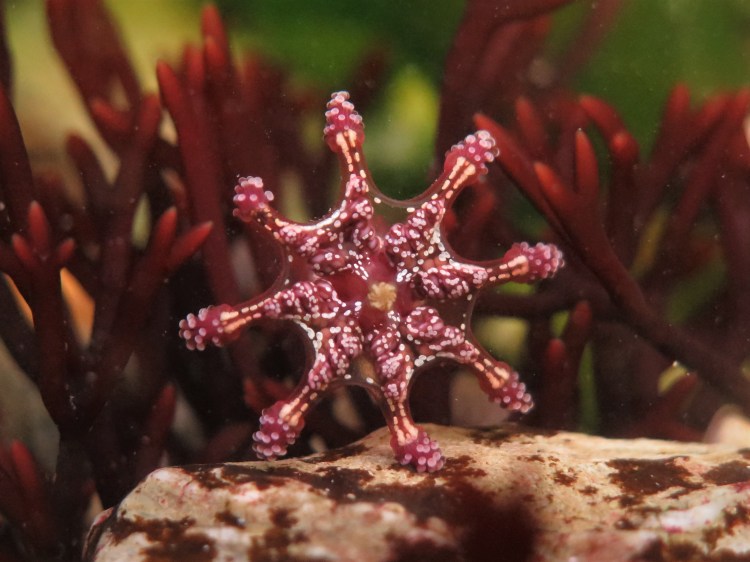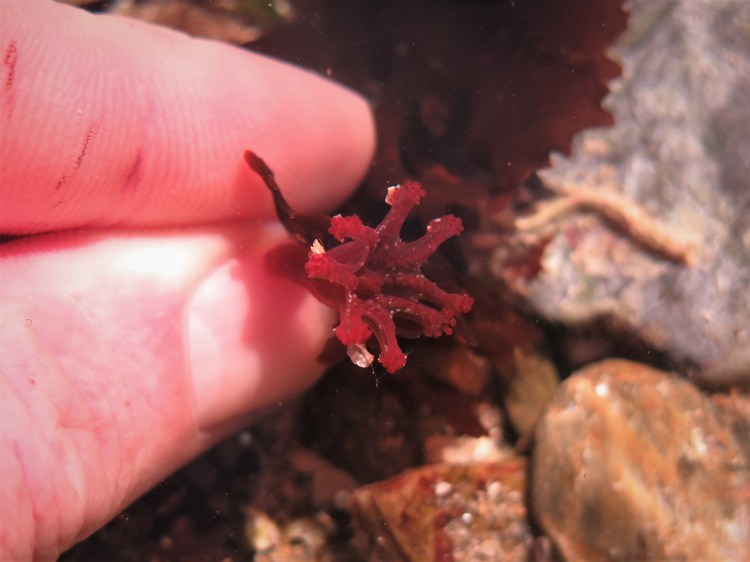 Two weeks ago we werelucky to spend a mid-week on St. Martins, one of the Scilly Islands. The Scillies are a group of tiny inhabited and uninhabited islands 28 miles off Lands’ End (before I moved to Cornwall eight years ago, I had never even heard of them…). The water over there is bluer, the sand is whiter and the viz much (much) better than in ‘mainland’ Cornwall, so a true paradise for snorkelling. I tried to get underwater as much as I could, in-between exploring the island (and going to the one pub). As we did not have much time, I mainly snorkelled in the seagrass just off Par Beach. It does not really look like England does it!?
Two weeks ago we werelucky to spend a mid-week on St. Martins, one of the Scilly Islands. The Scillies are a group of tiny inhabited and uninhabited islands 28 miles off Lands’ End (before I moved to Cornwall eight years ago, I had never even heard of them…). The water over there is bluer, the sand is whiter and the viz much (much) better than in ‘mainland’ Cornwall, so a true paradise for snorkelling. I tried to get underwater as much as I could, in-between exploring the island (and going to the one pub). As we did not have much time, I mainly snorkelled in the seagrass just off Par Beach. It does not really look like England does it!? 
 The seagrass was teeming with stalked jellyfish. However, because of the great viz I stuck with my fisheye lens, which meant it was tricky to photograph them. This species is Calvadosia campanulata, a protected and generally uncommon species, so worth recording (which I will get on when work is quieter and the weather is crappier). The ID was confirmed by expert David Fenwick, have a look at his excellent site on stalker jellies stauromedusae.co.uk (and his general site for marine species in the SW of the UK aphotomarine.com). Dave also pointed out some other organisms growing on the seagrass seen on these pics: the small red algae Rhodophysema georgei and the slime mold Labyrinthula zosterae (the black bits). As always, I learned something new talking to Dave.
The seagrass was teeming with stalked jellyfish. However, because of the great viz I stuck with my fisheye lens, which meant it was tricky to photograph them. This species is Calvadosia campanulata, a protected and generally uncommon species, so worth recording (which I will get on when work is quieter and the weather is crappier). The ID was confirmed by expert David Fenwick, have a look at his excellent site on stalker jellies stauromedusae.co.uk (and his general site for marine species in the SW of the UK aphotomarine.com). Dave also pointed out some other organisms growing on the seagrass seen on these pics: the small red algae Rhodophysema georgei and the slime mold Labyrinthula zosterae (the black bits). As always, I learned something new talking to Dave. 
 Snakelocks anemones were abundant on the seagrass, and the sand inbetween was full of Daisy anemones and Red-Speckled anemones Anthopleura balli (one of my favourites, they do well in my aquarium). As always, I bother crabs by sticking a lens in their face. Bigger Green Shore Crabs Carcinus maenas can get a bit feisty and attack the dome port (maybe because they see their own reflection). Finally a juvenile Straight-nosed Pipefish Nerophis ophidion (about 3 inches), a new one for me. I am always facinated by piepfish (and hope to one day see a seahorse). Unfortunately the shot is not in focus, I really needed a macrolens for this one. Still, you can marvel at the white sand and blue water! Some photos are allright, but I could do a lot better with a bit more time. Luckily we rebooked for a stay in spring already!
Snakelocks anemones were abundant on the seagrass, and the sand inbetween was full of Daisy anemones and Red-Speckled anemones Anthopleura balli (one of my favourites, they do well in my aquarium). As always, I bother crabs by sticking a lens in their face. Bigger Green Shore Crabs Carcinus maenas can get a bit feisty and attack the dome port (maybe because they see their own reflection). Finally a juvenile Straight-nosed Pipefish Nerophis ophidion (about 3 inches), a new one for me. I am always facinated by piepfish (and hope to one day see a seahorse). Unfortunately the shot is not in focus, I really needed a macrolens for this one. Still, you can marvel at the white sand and blue water! Some photos are allright, but I could do a lot better with a bit more time. Luckily we rebooked for a stay in spring already! 




Tag Archives: Calvadosia campanulata
Stalked Jellyfish: the Stauromedusae


 I now am the proud owner of a nauticam CMC wetlens. It arrived too late for my first encounter with a nudibranch this year, however, it came just in time for a proliferation of stalked jellyfish. These tiny (around one centimeter), sessile relatives of jellyfish are not very well-known, but seem to be getting more popular, see for some other recent finds the other local blogs Cornish Rock Pools and The Marine Enthusiast. To find them, you need to carefully scan seaweeds in rock pools (they are not very picky when it comes to which species they attach themselves to). The key resource for UK (European even) rock poolers is David Fenwick’s Stauromedusae website. Above, the most common species, the Spotted kaleidoscope jellyfish Haliclystus octoradiatus, recognizable by the primary tentacles or anchors (the white ‘balls’ inbetween the tentacles). Below, St. John’s stalked jellyfish Calvadosia cruxmelitensis, with a zoomed out photo and finger nail to give an idea of scale. Finally, two not so good photos of a third species Calvadosia campanulata taken above-water as these were located just below the surface. One more species can be found on mainland Cornwall (the Goblet stalked jellyfish Craterolophus convolvulus) and one on the Scillies (the Horned stalked jellyfish Lucernaria quadricornis, but who knows this species is also present on the mainland). So some more searching to do!
I now am the proud owner of a nauticam CMC wetlens. It arrived too late for my first encounter with a nudibranch this year, however, it came just in time for a proliferation of stalked jellyfish. These tiny (around one centimeter), sessile relatives of jellyfish are not very well-known, but seem to be getting more popular, see for some other recent finds the other local blogs Cornish Rock Pools and The Marine Enthusiast. To find them, you need to carefully scan seaweeds in rock pools (they are not very picky when it comes to which species they attach themselves to). The key resource for UK (European even) rock poolers is David Fenwick’s Stauromedusae website. Above, the most common species, the Spotted kaleidoscope jellyfish Haliclystus octoradiatus, recognizable by the primary tentacles or anchors (the white ‘balls’ inbetween the tentacles). Below, St. John’s stalked jellyfish Calvadosia cruxmelitensis, with a zoomed out photo and finger nail to give an idea of scale. Finally, two not so good photos of a third species Calvadosia campanulata taken above-water as these were located just below the surface. One more species can be found on mainland Cornwall (the Goblet stalked jellyfish Craterolophus convolvulus) and one on the Scillies (the Horned stalked jellyfish Lucernaria quadricornis, but who knows this species is also present on the mainland). So some more searching to do! 



